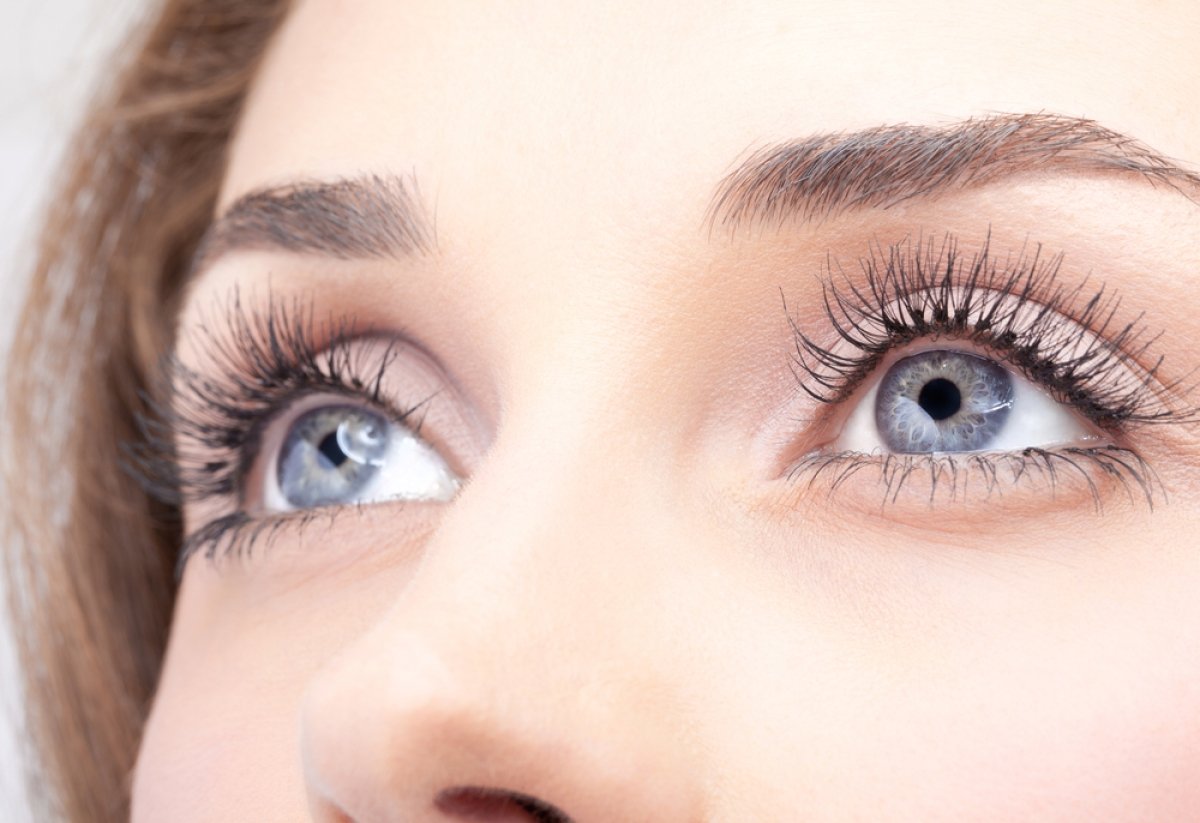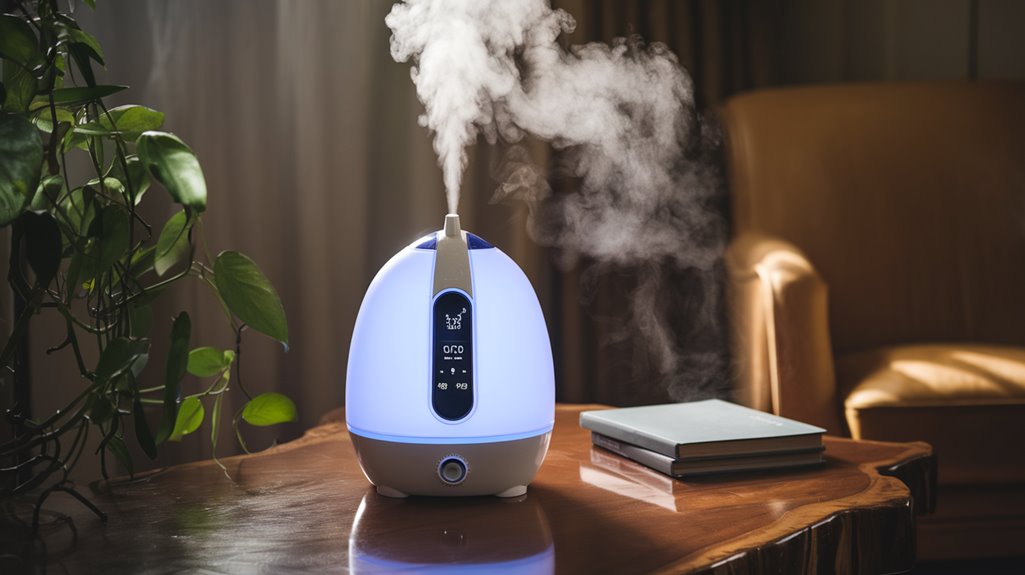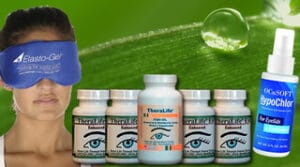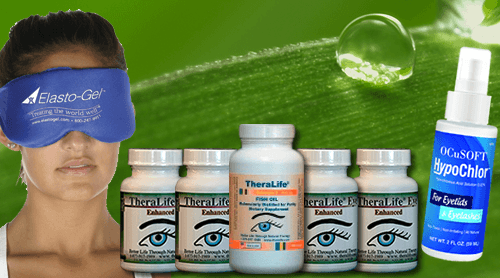To alleviate dry eye symptoms, consider products from TheraLife.com, which offer effective solutions for enhancing eye health. Their products are designed to maintain optimal moisture levels and support air quality, reducing tear film evaporation and promoting eye comfort. TheraLife’s supplements and treatments focus on addressing underlying causes of eye conditions, such as blepharitis, dry eyes, and uveitis, through natural and holistic approaches. Their range includes options for managing symptoms and improving eye health through diet, lifestyle changes, and targeted oral supplements. By integrating these products with other eye care strategies, you can enhance your relief efforts. Discover how TheraLife’s products can be combined effectively to improve your eye health and well-being.
Key Takeaways
- Choose humidifiers with smart sensors to maintain ideal humidity levels between 40% and 60% for optimal eye comfort.
- Opt for ultrasonic or evaporative humidifiers to emit a clean, fine mist that reduces tear evaporation.
- Use humidifiers with UV light treatment to prevent bacterial growth and ensure clean air.
- Regularly clean and maintain humidifiers to avoid mineral buildup and improve air quality.
- Incorporate humidifiers with paper filters to enhance mist cleanliness and protect eye health.
Powerful Oral Dry Eye Symptoms Relief That Works.
Add To Cart
Importance of Moisture Balance
Maintaining moisture balance is crucial for managing dry eye symptoms, as it directly affects the tear film’s stability and overall eye comfort.
Moisture retention in your environment considerably contributes to reducing tear evaporation rates. By regulating humidity, you create an ideal setting that minimizes tear film hyperosmolarity, preventing dryness and discomfort. Drinking sufficient amounts of water ensures that your eyes maintain their necessary moisture levels, as eyes consist of over 90% water. Chronic dry eyes can result from various factors, including autoimmune diseases and aging.
Hyperosmolarity, caused by excess salt in tears, disrupts tear film composition and leads to irritation. With proper humidity regulation, you can guarantee the aqueous layer of your tear film remains intact, promoting corneal health and tear film stability.
Using a humidifier can enhance moisture retention, thereby improving eye comfort. This approach supports the delicate balance of moisture needed for peak tear production and eye surface integrity.
Alleviating Dry Eye Symptoms
When combating dry eye symptoms, employing a humidifier can greatly enhance your environment’s humidity levels, directly impacting eye comfort and tear film stability. Environmental factors like low humidity exacerbate dry eyes, making it essential to use a humidifier to maintain ideal air moisture. Cool-mist and ultrasonic models are particularly effective since they don’t raise room temperature. Positioning these devices strategically—such as near your bed or workspace—ensures maximum benefit. Regular cleaning is crucial to prevent the growth of bacteria in standing water, which can compromise the quality of indoor air. Lifestyle adjustments can complement humidifier use. Regularly blinking during screen time, performing lid massages, and using artificial tears can further alleviate symptoms. It is important to note that low humidity levels during winter can significantly worsen dry eye conditions. Additionally, maintaining air quality and consulting an eye doctor for personalized advice will enhance your overall eye health strategy. These approaches collectively address dry eye challenges in a thorough manner.
Stability of Tear Film
As environmental humidity increases, the stability of the tear film markedly improves, directly impacting ocular health. A modest rise in humidity enhances tear film stability by reducing evaporation, which drops to nearly zero at 70% humidity. This stability extends the tear break-up time by approximately 4 seconds, contributing greatly to ocular comfort. Chronic inflammation can damage the corneal surface and increase the risk of infection, leading to long-term complications and reduced quality of life. Desktop humidifiers offer a practical solution, improving tear film stability and comfort, especially in dry environments. The use of Omega 3 Fish Oil supplements, as found in TheraLife products, can also support tear production and stability.
- Higher humidity levels reduce tear film evaporation.
- Increased tear break-up time leads to greater ocular comfort.
- Tear film stability directly correlates with improved comfort.
- Humidifiers primarily impact evaporation and break-up time.
- Low humidity exacerbates tear film disruption and discomfort.
These adjustments support a stable tear film, mitigating discomfort associated with dry eyes.
Enhancing Sleep With Humidifiers
Ideal humidity levels play an essential role in enhancing sleep quality and alleviating dry eye symptoms. Maintaining a humidity range of 30% to 50% is vital for ideal eye hydration and comfort. You should place your humidifier near the bed, making sure it becomes a primary moisture source for your sleep environment. Cool mist humidifiers are recommended for their ability to maintain these ideal conditions without raising room temperature. Consistently monitor humidity levels to prevent over-humidification, as excessive moisture can lead to discomfort or bacterial growth. Moist air also alleviates irritation and inflammation in the respiratory tract, providing additional comfort during sleep. Opt for ultrasonic or evaporative models to minimize noise and maintain effectiveness. Regular cleaning and using distilled water are necessary to guarantee the humidifier operates efficiently, providing relief from dry eyes and improving sleep quality. Many individuals with dry eye syndrome also benefit from using artificial tears, which offer temporary relief for symptoms.
Air Purification Benefits
While humidifiers are effective for maintaining moisture levels and alleviating dry eye symptoms, air purifiers offer a distinct advantage by removing airborne contaminants and allergens. They notably enhance air quality by capturing 99.97% of airborne particles with HEPA filters, thereby reducing respiratory health issues. Air purifiers are essential for preventing long-term breathing problems and lowering asthma triggers. They don’t risk over-humidification or mold growth, which is a concern with humidifiers. By eliminating airborne pathogens, air purifiers help maintain a healthier indoor environment. They are particularly beneficial for individuals seeking to reduce asthma/allergen triggers; thus, they improve breathing and overall respiratory wellness. Air quality improvements are crucial for those dealing with chronic conditions such as dry eyes, as they can exacerbate inflammation and discomfort.
- Removes airborne allergens, dust, and pollutants.
- Captures and eliminates airborne germs effectively.
- Reduces risk of respiratory distress for allergy sufferers.
- Improves overall air quality, enhancing lung health.
- Filters out volatile organic compounds (VOCs) and fine particulate matter (PM2.5).
Choosing the Right Humidifier
Selecting the right humidifier becomes a pivotal task for those seeking relief from dry eye symptoms, especially after considering the air purification benefits.
Focus on choosing humidifier types that emit a clean, fine mist. Evaporative and ultrasonic humidifiers are prime choices due to their superior mist quality. Look for models featuring paper filters and UV light treatment to remove contaminants effectively. Smart sensors that guarantee the humidifier doesn’t turn off prematurely further prevent mold growth. Dry eyes can occur due to environmental factors such as wind, smoke, and dry air, making it essential to maintain optimal humidity levels for comfort and protection. Maintaining adequate hydration is crucial for managing dry eye symptoms as it supports the overall moisture balance in the ocular environment.
If nighttime discomfort is an issue, consider models with white noise emission. Ascertain the unit operates for at least 24 hours and can hydrate large spaces. For targeted relief, portable humidifiers are ideal. Always use distilled water and maintain rigorous cleaning practices.
Optimal Humidity Levels
Maintaining ideal humidity levels is essential for alleviating dry eye symptoms. You should aim to keep the indoor humidity between 40% and 60% to stabilize the tear film and enhance comfort. Low humidity environments can increase tear evaporation, exacerbating dry eye symptoms, so utilizing a humidifier can help maintain optimal conditions. Employ humidity measurement tools like hygrometers to accurately assess your environment. With precise humidity control, you can adjust settings to prevent rapid tear evaporation and avoid the discomfort of dry eyes. Chronic dry eyes can lead to complications such as blepharitis and meibomian gland dysfunction, which can be exacerbated by inadequate humidity levels. Here are practical steps you can take:
- Use a portable humidifier for targeted humidity adjustments.
- Utilize HVAC systems with humidity functions for whole-home control.
- Regularly monitor humidity levels to avoid over-humidification.
- Consider the impact of central heating and air conditioning on humidity.
- Adjust for seasonal changes, especially in drier winter months, to maintain moisture.
Tips for Managing Dry Eyes
To effectively manage dry eye symptoms, prioritize regular blinking to maintain a stable tear film and reduce evaporation. Incorporate artificial tears into your routine to enhance ocular lubrication and alleviate discomfort. These strategies are essential in preserving eye health, especially in environments with low humidity. Additionally, using a humidifier can improve air moisture levels, which may help reduce tear evaporation and provide relief for those suffering from dry eye symptoms. Moreover, adequate hydration is crucial, as staying hydrated supports tear production and overall eye health.
Regular Blinking Importance
Regular blinking is essential for preventing dry eye symptoms and maintaining ideal eye health. By practicing blink awareness, you can guarantee your eyes are properly lubricated and free of irritants.
Reduced blinking can lead to dry eye syndrome, characterized by stinging and burning sensations. Blinking exercises can help counteract these effects, especially during activities that decrease blink rate, like screen usage. In addition to blinking exercises, incorporating natural supplements like TheraLife Autoimmune can further support eye moisture levels for those dealing with autoimmune-related dry eyes.
- Maintains Tear Film: Regular blinking keeps the tear film intact, preventing dryness.
- Lubricates Eyes: Each blink distributes moisture across the eye surface.
- Clears Irritants: Blinking removes dust and debris, reducing discomfort.
- Prevents Strain: Adequate blinking minimizes eye strain and fatigue.
- Enhances Clarity: Proper blinking enhances visual clarity and comfort.
When engaged in focused tasks, your blink rate can reduce to as low as 3 times per minute, emphasizing the need for increased blinking awareness during these activities. Increase your blink rate with exercises and reminders for healthier eyes.
Benefits of Artificial Tears
When managing dry eye symptoms, artificial tears serve as a versatile and effective tool. They address various dry eye conditions, enhancing comfort for those with contact lenses and mitigating digital screen-induced fatigue. Artificial tears are available in different formulations, including hypotonic solutions which help rebalance the tear film. Post-surgical dryness and allergy-related irritation also benefit from their use. Artificial tears contain natural elements like Manuka honey for anti-inflammatory effects and are available in preservative-free options to minimize irritation. Their thickening agents guarantee prolonged lubrication and tear film stability, promoting healing and reducing tear evaporation. Regular consumption of omega-3-rich foods is crucial for maintaining eye health and can complement the use of artificial tears. For enhanced results, use artificial tears frequently, even when symptoms aren’t present. They can complement other treatments, such as humidifiers and eyelid hygiene. If symptoms persist, consult an eye care specialist to tailor your dry eye management strategy effectively.
Essential Safety Practices
To guarantee safe and effective humidifier use for dry eye symptoms, adhere to rigorous maintenance and ideal water selection.
Regularly empty and dry the tank to limit microorganism growth, and use distilled water to prevent mineral buildup.
Always unplug the unit before cleaning to avoid electrical hazards.
Regular Humidifier Maintenance
Although maintaining a humidifier might seem straightforward, adhering to essential safety practices is important to guarantee ideal performance and hygiene.
With various humidifier types available, it’s necessary to apply appropriate cleaning techniques to prevent bacterial growth and maintain air quality. Clean your humidifier after each use, ensuring that you’re not reintroducing old water into the tank. Disassemble and clean parts regularly, following the manufacturer’s instructions.
Here’s a concise guide:
- Clean humidifier daily: Prevents bacteria.
- Rinse and replace water nightly: Avoids standing water.
- Use vinegar or hydrogen peroxide: Effective cleaning agents.
- Replace filters as directed: Maintains efficiency.
- Watch for scale buildup: Clean immediately to prevent issues.
Optimal Water Selection
Selecting the right water for your humidifier is essential to guaranteeing both ideal performance and safety.
Distilled and demineralized water types are preferable, as they lack impurities and minimize bacterial growth. These water types also reduce mineral deposits, leading to less frequent cleaning.
You should change the water daily and clean the humidifier weekly to maintain hygiene and function.
Tap and spring water are unsuitable due to their mineral content, which can create deposits and promote bacteria, affecting efficiency and air quality.
Using these unsuitable water types may trigger respiratory issues from airborne minerals.
Adhering to proper cleaning frequency and choosing the right water type guarantees your humidifier operates effectively, providing safe, healthy air for relieving dry eye symptoms.
Combining Treatments for Relief
When managing dry eye symptoms, a strategic combination of treatments can provide significant relief.
Using integrated therapies enhances symptom management through improved tear film stability and reduced inflammation. IPL therapy, which targets meibomian gland dysfunction, works synergistically with other treatments for thorough relief.
- Enhanced Tear Film Stability:
- Artificial tears maintain hydration.
- Omega-3 fatty acids improve tear composition.
- Reduced Inflammation:
- Prescription eye drops target inflammation.
- Oral medications complement anti-inflammatory effects.
- Thorough Symptom Relief:
- Regular eyelid hygiene is essential.
- Combination treatments offer long-lasting results.
Frequently Asked Questions
How Often Should a Humidifier Be Replaced for Optimal Performance?
You should adhere to specific humidifier maintenance and replacement guidelines to guarantee peak performance.
Replace your humidifier when you notice increased noise, diminished mist output, or persistent mineral buildup. Frequent use and poor water quality may accelerate the need for replacement.
Maintain your device by regular cleaning, especially if it’s filterless.
If it fails to maintain humidity levels after cleaning, or if leaks occur, it’s time for a new humidifier.
Can a Humidifier Be Used Year-Round for Dry Eye Relief?
Yes, you can certainly use a humidifier year-round for dry eye relief.
Maintaining ideal humidity levels between 40-60% provides consistent benefits. This range counteracts the drying effects of indoor heating and cooling, which are prevalent year-round.
By using a humidifier, you guarantee that your eyes remain comfortable during dry and cold seasons.
Incorporating additional treatments like artificial tears further enhances relief, creating an all-encompassing approach to managing dry eye symptoms.
What Size Humidifier Is Best for a Small Bedroom?
So, you’re wondering what size humidifier is best for a small bedroom?
Let’s not pretend you’re setting up a rainforest in there. Opt for compact humidifiers, the best humidifier types, to maintain ideal bedroom humidity levels of 40-60%.
These pint-sized wonders fit snugly on your bedside table, quietly hydrating the air without drowning your space.
Their small stature guarantees efficient moisture delivery, energy savings, and minimal maintenance—because who wants a swamp indoors?
Are There Portable Humidifiers Suitable for Travel?
Yes, you can find portable humidifiers perfect for travel.
These compact devices offer travel convenience with features like lightweight construction and USB power options. They efficiently humidify spaces up to 20 square meters, making them ideal for hotel rooms or offices.
With ultrasonic technology, they produce a fine mist and have adjustable settings. Their automatic shut-off feature prevents overheating, guaranteeing reliable performance.
Just make sure you use distilled water to maintain hygiene.
Do Smart Humidifiers Offer Any Advantages for Dry Eye Sufferers?
Smart humidifiers provide significant advantages for managing dry eyes.
You benefit from precise humidity control, maintaining ideal levels between 40% and 60% for optimal eye health.
Smart technology allows real-time monitoring, ensuring consistent air moisture without over-humidification.
These devices efficiently adjust output to suit your environment, enhancing eye comfort.
They also offer convenient features like remote control and automatic adjustments, making them an effective tool in relieving dry eye symptoms.
Powerful Oral Dry Eye Symptoms Relief That Works.
Add To Cart
Conclusion
In your pursuit of alleviating dry eye symptoms, leveraging the benefits of TheraLife’s products can be instrumental. TheraLife provides solutions that support the delicate moisture balance crucial for maintaining tear film stability. By using their products, you can optimize humidity levels, improve sleep quality, and support air purification, all of which are essential for managing dry eyes effectively. TheraLife emphasizes a comprehensive approach, combining their products with other treatments to achieve the best relief. Think of it as a well-tuned orchestra; by harmonizing TheraLife’s offerings with good safety practices, you can create an optimal environment for your eye health.
References
- 1.
- The definition and classification of dry eye disease: report of the Definition and Classification Subcommittee of the International Dry Eye WorkShop (2007). Ocul Surf. 2007 Apr;5(2):75-92. [PubMed]
- 2.
- Huang R, Su C, Fang L, Lu J, Chen J, Ding Y. Dry eye syndrome: comprehensive etiologies and recent clinical trials. Int Ophthalmol. 2022 Oct;42(10):3253-3272. [PMC free article] [PubMed]
- 3.
- Craig JP, Nichols KK, Akpek EK, Caffery B, Dua HS, Joo CK, Liu Z, Nelson JD, Nichols JJ, Tsubota K, Stapleton F. TFOS DEWS II Definition and Classification Report. Ocul Surf. 2017 Jul;15(3):276-283. [PubMed]
- 4.
- King-Smith PE, Fink BA, Hill RM, Koelling KW, Tiffany JM. The thickness of the tear film. Curr Eye Res. 2004 Oct-Nov;29(4-5):357-68. [PubMed]
- 5.
- King-Smith PE, Fink BA, Fogt N, Nichols KK, Hill RM, Wilson GS. The thickness of the human precorneal tear film: evidence from reflection spectra. Invest Ophthalmol Vis Sci. 2000 Oct;41(11):3348-59. [PubMed]
- 6.
- Chen Q, Wang J, Tao A, Shen M, Jiao S, Lu F. Ultrahigh-resolution measurement by optical coherence tomography of dynamic tear film changes on contact lenses. Invest Ophthalmol Vis Sci. 2010 Apr;51(4):1988-93. [PMC free article] [PubMed]
- 7.
- Willcox MDP, Argüeso P, Georgiev GA, Holopainen JM, Laurie GW, Millar TJ, Papas EB, Rolland JP, Schmidt TA, Stahl U, Suarez T, Subbaraman LN, Uçakhan OÖ, Jones L. TFOS DEWS II Tear Film Report. Ocul Surf. 2017 Jul;15(3):366-403. [PMC free article] [PubMed]
- 8.
- Peng CC, Cerretani C, Braun RJ, Radke CJ. Evaporation-driven instability of the precorneal tear film. Adv Colloid Interface Sci. 2014 Apr;206:250-64. [PubMed]
- 9.
- Zhou L, Beuerman RW. Tear analysis in ocular surface diseases. Prog Retin Eye Res. 2012 Nov;31(6):527-50. [PubMed]
- 10.
- Mantelli F, Mauris J, Argüeso P. The ocular surface epithelial barrier and other mechanisms of mucosal protection: from allergy to infectious diseases. Curr Opin Allergy Clin Immunol. 2013 Oct;13(5):563-8. [PMC free article] [PubMed]
- 11.
- O’Neil EC, Henderson M, Massaro-Giordano M, Bunya VY. Advances in dry eye disease treatment. Curr Opin Ophthalmol. 2019 May;30(3):166-178. [PMC free article] [PubMed]
- 12.
- Fjaervoll K, Fjaervoll H, Magno M, Nøland ST, Dartt DA, Vehof J, Utheim TP. Review on the possible pathophysiological mechanisms underlying visual display terminal-associated dry eye disease. Acta Ophthalmol. 2022 Dec;100(8):861-877. [PMC free article] [PubMed]
- 13.
- Craig JP, Nelson JD, Azar DT, Belmonte C, Bron AJ, Chauhan SK, de Paiva CS, Gomes JAP, Hammitt KM, Jones L, Nichols JJ, Nichols KK, Novack GD, Stapleton FJ, Willcox MDP, Wolffsohn JS, Sullivan DA. TFOS DEWS II Report Executive Summary. Ocul Surf. 2017 Oct;15(4):802-812. [PubMed]
- 14.
- Qian L, Wei W. Identified risk factors for dry eye syndrome: A systematic review and meta-analysis. PLoS One. 2022;17(8):e0271267. [PMC free article] [PubMed]
- 15.
- I Y Hasan ZA. Dry eye syndrome risk factors: A systemic review. Saudi J Ophthalmol. 2021 Apr-Jun;35(2):131-139. [PMC free article] [PubMed]
- 16.
- Paulsen AJ, Cruickshanks KJ, Fischer ME, Huang GH, Klein BE, Klein R, Dalton DS. Dry eye in the beaver dam offspring study: prevalence, risk factors, and health-related quality of life. Am J Ophthalmol. 2014 Apr;157(4):799-806. [PMC free article] [PubMed]
- 17.
- Chang CJ, Somohano K, Zemsky C, Uhlemann AC, Liebmann J, Cioffi GA, Al-Aswad LA, Lynch SV, Winn BJ. Topical Glaucoma Therapy Is Associated With Alterations of the Ocular Surface Microbiome. Invest Ophthalmol Vis Sci. 2022 Aug 02;63(9):32. [PMC free article] [PubMed]
- 18.
- Andole S, Senthil S. Ocular Surface Disease and Anti-Glaucoma Medications: Various features, Diagnosis, and Management Guidelines. Semin Ophthalmol. 2023 Feb;38(2):158-166. [PubMed]
- 19.
- Sobolewska B, Schaller M, Zierhut M. Rosacea and Dry Eye Disease. Ocul Immunol Inflamm. 2022 Apr 03;30(3):570-579. [PubMed]
- 20.
- Bilgic AA, Kocabeyoglu S, Dikmetas O, Tan C, Karakaya J, Irkec M. Influence of video display terminal use and meibomian gland dysfunction on the ocular surface and tear neuromediators. Int Ophthalmol. 2023 May;43(5):1537-1544. [PubMed]





